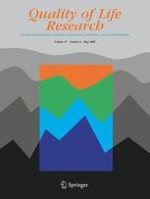01-05-2008
Identifying response shift statistically at the individual level
Gepubliceerd in: Quality of Life Research | Uitgave 4/2008
Log in om toegang te krijgenAbstract
Objective
The purpose of this study was to explore whether a longitudinal comparison between reported and predicted health could be used as a method of identifying subjects who potentially experienced response shift.
Methods
A response-shift model was developed using data from a longitudinal study of stroke in which measures of stroke impact were made at study entry and at 1, 3, 6, and 12 months post stroke. Residuals from a random effects model were centered and used to create trajectories. This model was tested against a data set from a study in which the then-test had been administered. Twenty simulated data sets were also generated to examine how much of response shift could be attributed to random error.
Results
Group-based trajectory analysis identified seven trajectory groups. The majority (67%) of the 387 persons showed no response shift over time, whereas 15% lowered and 13% raised their health over time, disproportionally to that predicted.
Conclusion
Results of the validation studies were supportive that this methodology identifies response shift, but further research is required to compare results with other methodologies and other predictive models.
